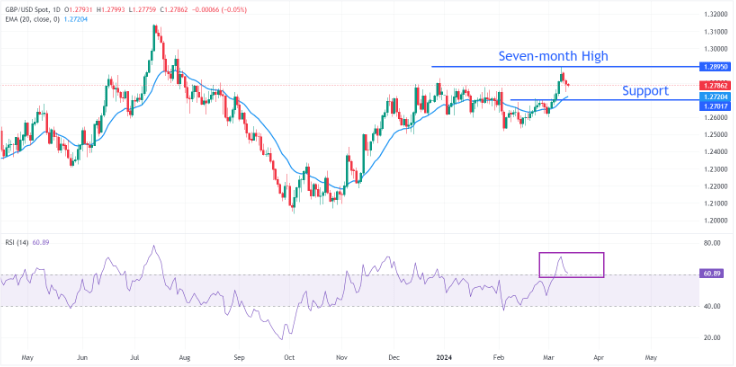- The Pound Sterling bounces back as the UK’s monthly GDP meets anticipated levels, despite a downturn in factory data.
- Expectations for a Bank of England (BoE) rate cut in August gain traction following disappointing employment figures for the three-month period ending January.
- Despite diminishing hopes for a Federal Reserve rate cut in June, the US Dollar experiences a minor decline.
In Wednesday’s early American session, the Pound Sterling (GBP) stages a recovery as market sentiment retains a cautious optimism. The GBP/USD pair rebounds to 1.2800 following reports from the United Kingdom’s Office for National Statistics (ONS), which reveal that the growth in monthly Gross Domestic Product (GDP) and Manufacturing Production data for January align closely with market expectations. However, Industrial Production data for the same period falls below consensus estimates.
The UK economy exhibits a growth of 0.2% in January, marking a rebound after experiencing a technical recession in the latter half of 2023. This suggests that the recession was relatively mild and indicates an improvement in economic prospects.
Looking ahead, the trajectory of the Pound Sterling will be influenced by signals regarding the timing of potential interest rate reductions by the Bank of England (BoE). Expectations for a BoE rate cut starting in August have risen in response to weakening labor market conditions and decreasing inflation expectations.
Daily digest market movers: Pound Sterling revives while US Dollar slips
- The Pound Sterling rebounds following the release of data from the Office for National Statistics (ONS), indicating that the United Kingdom’s economy expanded by 0.2% in January, aligning with market forecasts. This growth comes after a 0.1% contraction in December.
- However, the monthly Manufacturing Production remains stagnant in January, as expected, down from the 0.8% growth recorded in December. On an annual basis, the economic data shows growth of 2.0%, meeting expectations but decelerating from the previous reading of 2.3%.
- Surprisingly, Monthly Industrial Production declines by 0.2%, contrary to projections of a flat performance, following a 0.6% rise in December. Additionally, the annual factory data grows at a slower pace of 0.5% compared to expectations of 0.7%, and the previous reading of 0.6%.
- While the monthly GDP growth suggests an improving economic outlook, factory activity continues to face challenges.
- Meanwhile, there’s a slight increase in market expectations for the Bank of England to reduce interest rates in August, driven by easing inflation expectations and cooling labor market conditions in the three months ending January. According to US bank Citi, consumer inflation expectations for the next 12 months dropped to 3.6% in February from 3.9% in January.
- Surprisingly, the UK’s Unemployment Rate climbs to 3.9%, accompanied by a decline in employment levels, and Average Earnings excluding bonuses grow at their slowest pace since October 2022. Nevertheless, wage growth remains approximately double the level needed to bring down inflation to the 2% target.
- Meanwhile, the market sentiment remains subdued as persistent United States Consumer Price Index (CPI) data for February raise expectations for the Federal Reserve to maintain interest rates steady in the first half of 2024. The hot US inflation data reinforces the Fed’s hawkish stance.
- The US Dollar Index (DXY), measuring the Greenback’s value against six rival currencies, experiences a slight decline to 102.80.
Technical Analysis: Pound Sterling trades close to 1.2800

The Pound Sterling extends its downtrend for the third consecutive trading session on Wednesday. The GBP/USD pair falls below the significant support level of 1.2800. Market analysis suggests that the asset is likely to decline towards the 20-day Exponential Moving Average (EMA), currently positioned around 1.2720. Additionally, the round-level support at 1.2700 is anticipated to serve as a robust support level for Pound Sterling bulls.
The 14-period Relative Strength Index (RSI) retreats to 60.00 after reaching overbought levels. A decisive break below the 60.00 mark would signal a fading bullish momentum.
